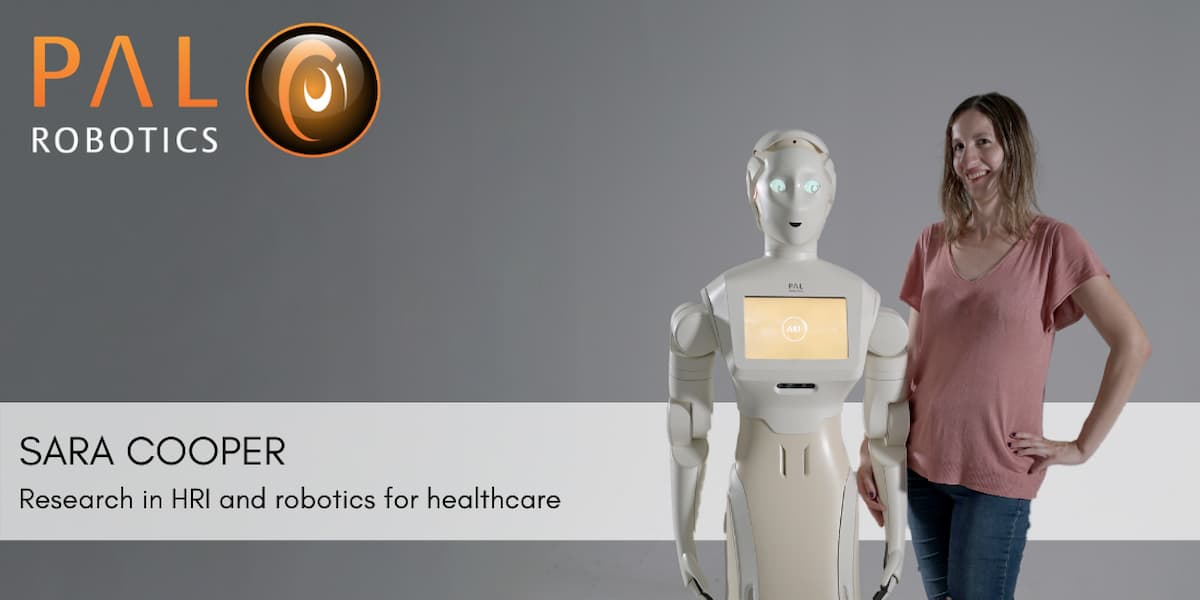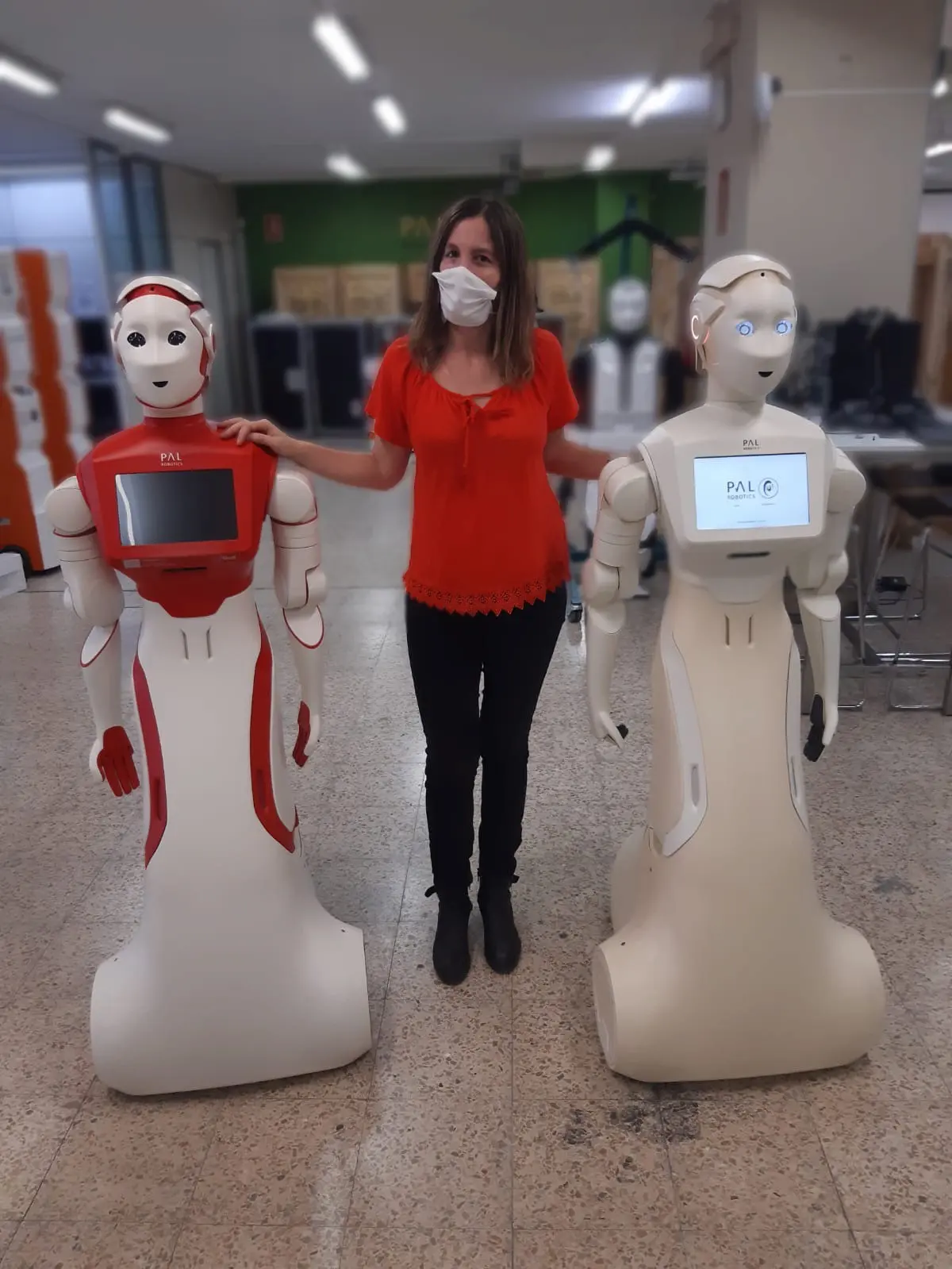Assistive robotics expert Sarah Cooper on healthcare robotics
PAL Robotics’ software engineer, Sara Cooper, recently won the best paper award at Heriot-Watt University with her master thesis, “An EEG investigation on planning human-robot handover tasks”. We spoke with Sara to learn more about the research in HRI that went into her paper, as well as her special interests in prosthetics and rehabilitation robotics, and her work at PAL Robotics with ARI and TIAGo robots.
Please can you tell us more about your background?
Sara told us “I am a robotics enthusiast originally from Donostia-San Sebastián, in the Basque Country, northern Spain.” Sara highlighted improving health through use of technology as key passion, explaining, “I studied Biomedical Engineering at Mondragon Unibertsitatea, as I was passionate about finding new ways of improving health through technology, from prosthetics to surgical robotics, and by my final year I took a special interest in assistive robotics. For this in London I carried out a research project using a social robot for cognitive training, and then pursued a MSc at Heriot-Watt University, Edinburgh, specifically in robotics, which consequently brought me to PAL Robotics!”

Robotic prosthetics and rehabilitation robotics
What got you interested in robotics?
Sara continued, mentioning robotic prosthesis and rehabilitation as particular driving factors for her initial interest in robotics, explaining, “Originally my interest was in robotic prosthetics and rehabilitation robotics, as I believed that having an impairment or physical difficulty can be made more bearable if we use devices that not only improve our quality of life but also make it fun along the way! Think also how surgery has advanced through the use of robots like Da Vinci. Programming and maths were also always two subjects that I liked a lot, which turned my adoration to something that I felt that I could get involved in.”
Research in HRI for assisted living and healthcare
What was your final thesis about and how did you feel winning the best paper award?
Sara went on to discuss her research on HRI for assisted living and healthcare, explaining, “The thesis, entitled “An EEG investigation on planning human-robot handover tasks” consists of a combined human-robot interaction and psychology human-robot handover experiment. It was carried out at the Robotic Assisted Living Testbed as part of the CARE Group, that is a section of the Edinburgh Centre of Robotics. The goal of the lab is to develop systems for ambient assisted living.
The novelty of the paper lies on the psychological aspect, as we have used EEG (Electroencephalogram) in order to evaluate how humans plan an action that they are told to do with a robot in advance. When we carry out a joint action with another person, such as exchanging an object, we tend to predict what they will do, and adapt our behaviour accordingly, and that is what makes the action efficient and easy to do. This study shows that when a human needs to pass an object to a robot, they appear to plan it as a more complex action -higher demand- than with a human, that is, they likely predict it. This suggests that we should design robot interfaces carefully to either reduce the cognitive load, or take advantage of the planning the human does. Winning the best paper was unexpected but extremely satisfying, as it was a lot of hard work on a topic I had little experience in, I would also like to highlight the motivation of the participants in the experiment!”
You can find Sara Cooper’s final thesis here:
S. Cooper, S. F. P. Fensome, D. Kourtis, S. Gow and M. Dragone, “An EEG investigation on planning human-robot handover tasks,” 2020 IEEE International Conference on Human-Machine Systems (ICHMS), Rome, Italy, 2020, pp. 1-6, doi: 10.1109/ICHMS49158.2020.9209543.
And the presentation with a more detailed explanation on the experiments here:
Projects at PAL Robotics and learning more
Can you tell us a bit more about your work at PAL Robotics? For example, which robots do you work with? Which projects are you involved in at PAL Robotics?
Sara explained to us her work in European research projects, especially those connected to healthcare, telling us, “At PAL Robotics I work as part of the team of collaborative projects, in particular on projects related to healthcare and social/collaborative robotics – right now these include SHAPES, SPRING and SIMBIOTS. The main robot I work with is ARI, which has great capabilities for social interaction, and I still get to use TIAGo as well for projects requiring manipulation. As such I have worked on navigation, control, speech recognition, and developing some applications.”
What advice would you give to robotics enthusiasts keen to get started in the industry?
With regards to learning and experimenting with robotics, Sara went on to say, “I would suggest taking any kind of opportunity to delve yourself into the world of technology, such as building your first robots using Arduino/Raspberry, follow online tutorials or even ROS Ignite Academy, which is how I first started learning ROS (Robotics Operating System). Of course,if you lean towards the software development side, try to polish your C++ / Python skills, and remember that robotics is an interdisciplinary skill – topics such as computer vision, natural language processing, kinematics, deep learning will get you far. More than anything, I would suggest you try to have or build a robot and start to teach it different things, as small as they seem to be.”
We would like to thank Sara Cooper for taking the time to talk with us. If you have any questions for Sara with regards to her research paper, you can get in touch with her at sara.cooper@pal-robotics.com. To learn about the capabilities of our social humanoid robots ARI and TIAGo as mentioned in this blog, take a look at our website. Finally, if you would like to ask us more about our research platforms, do not hesitate to get in touch with us.
If you found this article interesting, don’t forget to explore our blog on robotics and technology!

